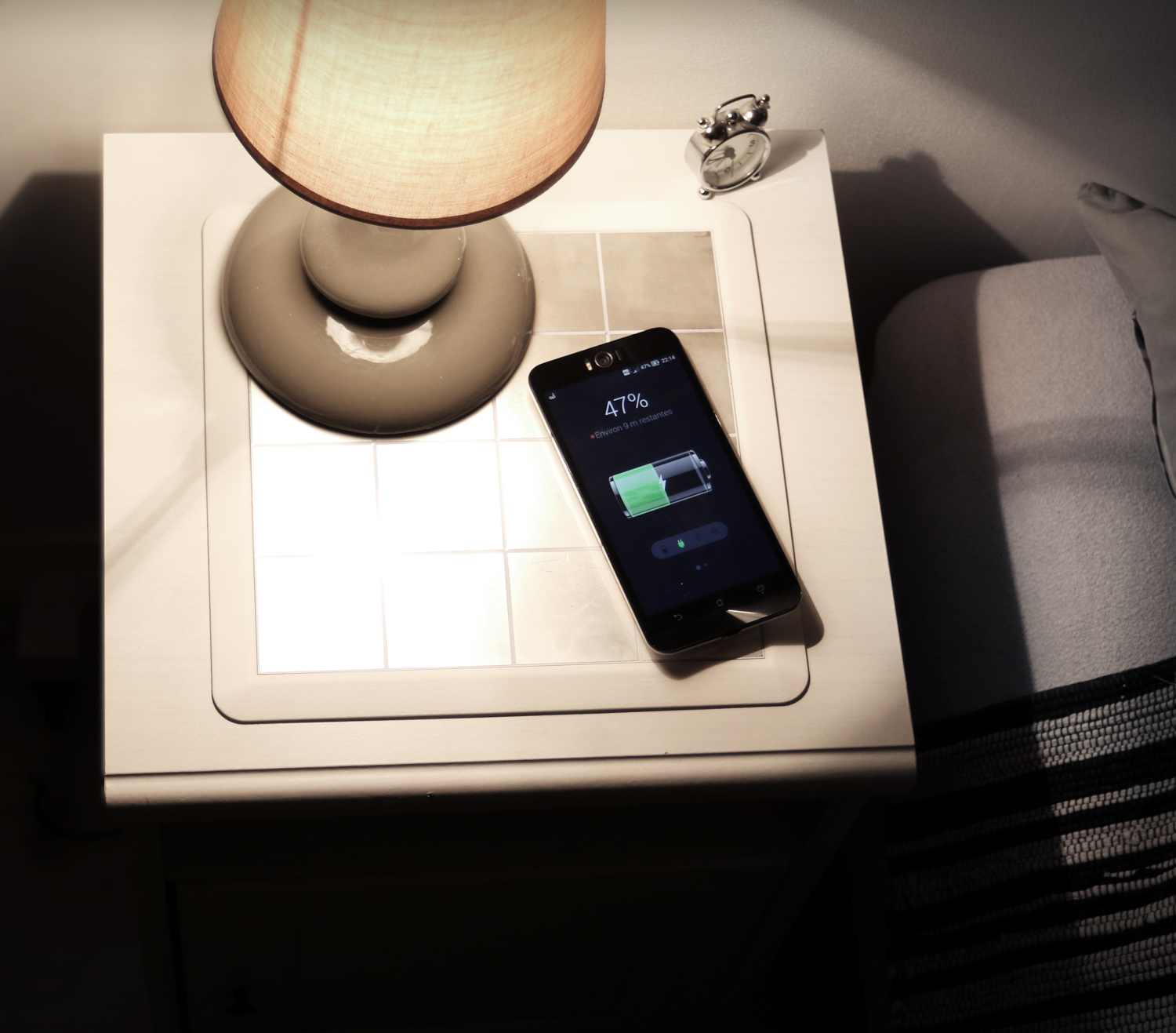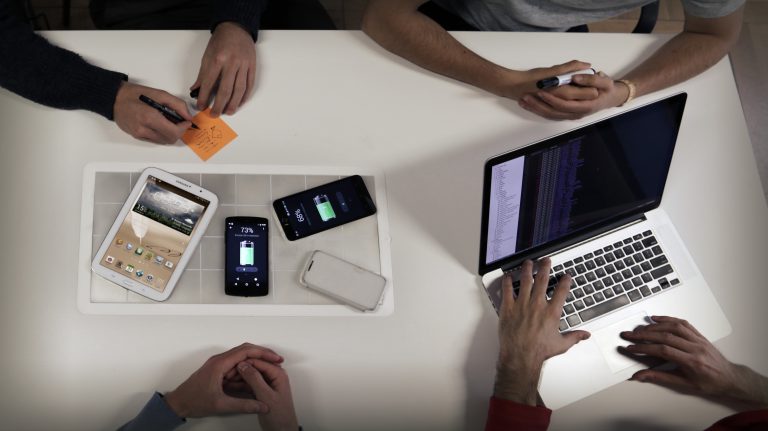Energysquare: charging your telephone has never been so simple!
Start-up company Energysquare has created a wireless charging device for tablets and cellphones. Using a simple mechanism combining a sticker and a metal plate, devices can be charged by conduction. Energysquare, which is incubated at Télécom ParisTech, will soon see its technology tested in hotels. The company now also aims to export and adapt its product to other smart objects.
Are you fed up of jumbles of wire in the house or on your desk? You probably never deliberately knotted your phone charger, and yet, when you want to use it, the wire is all tangled up! This article brings you good news: your fight against electric cables has come to an end! Start-up company Energysquare, incubated at Télécom ParisTech since 2015, has revolutionized electrical charging for mobile devices such as smartphones and tablets by disposing with current chargers. Your devices can now all be charged together on a single pad plugged into the mains.
“We based our work on the fact that the devices we use spend a lot of time on the surfaces around us, such as a desk or bedside table. Our idea was to be able to charge them over a whole surface and no longer with a cable at a single point,” explains Timothée Le Quesne, one of the designers of the Energysquare concept. We took a closer look at this vital accessory for future smart houses.
Easy-to-use conductive charging
The first question that comes to mind is how does it work? The technology is composed of two parts. Firstly, the pad, which is a 30×30-centimetre metal plate with independent conductive squares. It is plugged into the mains and can be placed on any surface as desired. The second part is a sticker comprising a flexible conductor with two electrodes and a connector adapted to the charging socket of your device, whether Android or IOS. The sticker is stuck directly on the back of your telephone. No surprises so far… but it is when the two parts come into contact that the magic happens.
When the electrodes come in contact with the charging surface, the system detects the device and sends it a signal to check that it is a battery. An electrical potential of 5 volts is produced between the two squares connected to the electrodes, allowing conductive charging. “The geometric format of the pad has been designed so that the two squares are automatically in contact with the electrodes. That way, there is no need to check anything and the device charges automatically without emitting any electromagnetic waves. Conversely, when no devices are detected, the pad automatically goes on standby,” explains Timothée Le Quesne.
But what happens if another device is placed on the pad? “The surface is naturally inert. The cleverness of the system lies in the fact that it can detect the object and identify whether it is a battery to be charged or not. Even if you spill water on it, it won’t have any effect. It is water resistant and protected against infiltration,” explains the young entrepreneur. No electric current is transmitted to your cup of coffee placed absentmindedly on the surface either. Although the system uses conductive charging, it does not emit any heat when it is running. Heat is dispersed across the surface like in a radiator, even if several devices are charging at once at the same speed as when plugged into the mains. Charging a device becomes so practical you could easily forget your phone lying on the surface. But this is not a problem, because the system goes back into standby once the device is fully charged.
Hotels soon to be using this technology
“We most need electricity when we’re away. We often have low battery in airports, cafes etc… This is a B2B market that we aim to invest in,” explains Timothée Le Quesne. For the moment, Energysquare is addressing the hospitality sector with tests to be carried out in France over the coming weeks. The principle is simple: the pad is installed on a bedside table and the stickers are provided at reception.
But the start-up aims to go even further. Why place the pad on a surface when it could be directly integrated into the furniture it sits on? “Our only limitation is preserving the metal surface of the pad to allow it to charge. We can still add a bit of style though by giving it a brushed effect, for example. Working with furniture manufacturers offers us good prospects. We can already imagine surfaces in meeting rooms covered with our device! We can also give the pad any form we like, with larger or smaller sections according to the device it is designed for,” Timothée Le Quesne continues.
With such a universal system, we can reasonably ask what the start-up’s aims are for the international market. “In January we will be participating in CES, an electronics show in the USA, where we will have a stand to display and demonstrate our technology.” This welcome overseas publicity is hardly a surprise since the start-up saw positive interest in its technology during a fundraiser on Kickstarter in June 2016, with 1/3 of purchasers in Asia and 1/3 in America. “As soon as we have finished validating our tests in hotels in France, we will turn to the foreign market,” affirms Timothée Le Quesne. But don’t worry, Energysquare hasn’t forgotten private individuals, and will launch the online sale of its technology in 2017.
Smart objects: a promising market to conquer
“One of our aims is to become a standard charging device for all smart objects,” admits Timothée Le Quesne. This is a promising future market, since 20 billion smart objects are forecast to be manufactured between now and 2020… All the more technology for us to spend time plugging in to charge! The start-up has already carried out tests with positive results on smart speakers and e-cigarettes, but the shape of certain objects, such as smart headphones, prevents the Energysquare system adapting to them. “For some devices, the electrodes will have to be integrated directly by the manufacturer.”
Nevertheless, there is one item that we use every day which would definitely benefit from this sort of charging system: laptops! The main difficulty, unlike other objects, is the power that needs to be generated by the system. “We need to change certain components to obtain more power through the pad and adapt it to laptops. It is something that is scheduled for 2017,” affirms Timothée Le Quesne. This is the first obstacle to overcome, especially since, when we asked the young entrepreneur what the future for Energysquare looked like 5 to 10 years from now, he replied: “we would like to be able to not only charge devices, but also power household appliances directly. We want to get rid of electric cables and replace them with surfaces that will power your kettle and charge your phone.”






Leave a Reply
Want to join the discussion?Feel free to contribute!